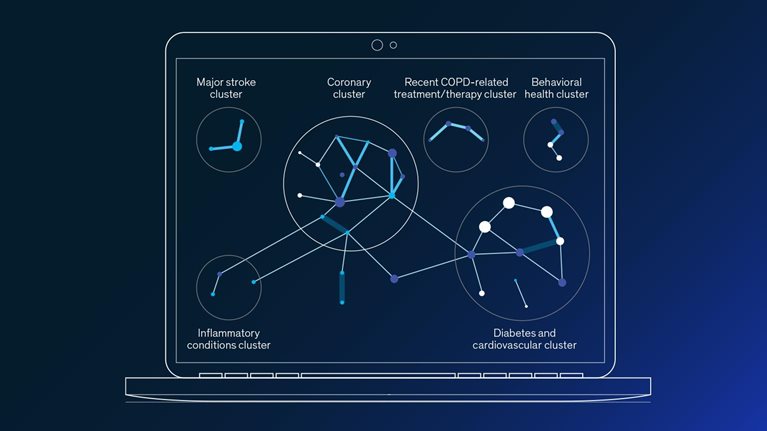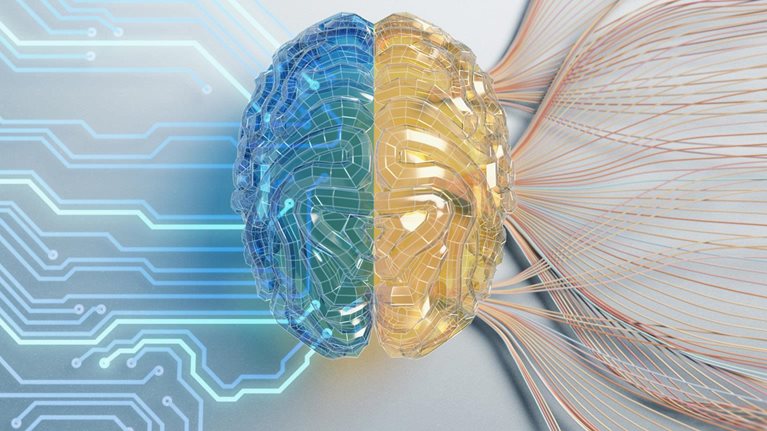At a convention center in Chicago in April, tens of thousands of attendees watched as a new generative-AI (gen AI) technology, enabled by GPT-4, modeled how a healthcare clinician might use new platforms to turn a patient interaction into clinician notes in seconds.
Here’s how it works: a clinician records a patient visit using the AI platform’s mobile app. The platform adds the patient’s information in real time, identifying any gaps and prompting the clinician to fill them in, effectively turning the dictation into a structured note with conversational language. Once the visit ends, the clinician reviews, on a computer, the AI-generated notes, which they can edit by voice or by typing, and submits them to the patient’s electronic health record (EHR). That near-instantaneous process makes the manual and time-consuming note-taking and administrative work that a clinician must complete for every patient interaction look archaic by comparison.
Gen-AI technology relies on deep-learning algorithms to create new content such as text, audio, code, and more. It can take unstructured data sets—information that has not been organized according to a preset model, making it difficult to analyze—and analyze them, representing a potential breakthrough for healthcare operations, which are rich in unstructured data such as clinical notes, diagnostic images, medical charts, and recordings. These unstructured data sets can be used independently or combined with large, structured data sets, such as insurance claims.
Like clinician documentation, several cases for gen AI in healthcare are emerging, to a mix of excitement and apprehension by technologists and healthcare professionals alike. Although healthcare businesses have used AI technology for years—adverse-event prediction and operating-room scheduling optimization are two examples—gen AI represents a meaningful new tool that can help unlock a piece of the unrealized $1 trillion of improvement potential present in the industry. It can do so by automating tedious and error-prone operational work, bringing years of clinical data to a clinician’s fingertips in seconds, and by modernizing health systems infrastructure.
To realize that potential value, healthcare executives should begin thinking about how to integrate these models into their existing analytics and AI road maps—and the risks in doing so. In healthcare, those risks could be dangerous: patient healthcare information is particularly sensitive, making data security paramount. And, given the frequency with which gen AI produces incorrect responses, healthcare practitioner facilitation and monitoring, what’s known as having a “human in the loop,” will be required to ensure that any suggestions are beneficial to patients. As the regulatory and legal framework governing the use of this technology takes shape, the protection of safe use will fall on users.

Tech that moves everything
There’s tech. Then there’s tech that reimagines and rewires organizations - powered by people, built with AI, and proven to create lasting value.
In this article, we outline the emerging gen-AI use cases for private payers, hospitals, and physician groups. Many healthcare organizations are more likely to start with applying gen AI to administrative and operational use cases, given their relative feasibility and lower risk. Over time, once they have more experience and confidence in the technology, these organizations may start to use gen AI with clinical applications.
Even with all the precautions that applying gen AI to the healthcare industry necessitates, the possibilities are potentially too big for healthcare organizations to sit it out. Here’s how private payers and healthcare providers can begin.
Use of gen AI by private payers, hospitals, and physician groups
In the near term, insurance executives, hospital administrators, and physician group operators may be able to apply gen-AI technology across the value chain. Such uses range from continuity of care to network and market insights to value-based care (see sidebar, “Potential uses of generative AI in healthcare”).
Private payers
Consumers are demanding more personalized and convenient services from their health insurance. At the same time, private payers face increasing competitive pressure and rising healthcare costs. Gen AI can help private payers’ operations perform more efficiently while also providing better service to patients and customers.
While many operations—such as managing relationships with healthcare systems—require a human touch, those processes can still be supplemented by gen-AI technology. Core administrative and corporate functions and member and provider interactions involve sifting through logs and data, which is a time-consuming, manual task. Gen AI can automatically and immediately summarize this data regardless of the volume, freeing up time for people to address more complex needs.
Member services offer many ways for gen AI to improve the quality and efficiency of interactions. For example, many member inquiries relate to benefits, which require an insurance specialist to manually confirm the scope of a member’s plan. With gen AI, digital resources and call-center specialists can quickly pull relevant information from across dozens of plan types and files. Resolution of claims denials, another time-consuming process that often causes member dissatisfaction, can be sped up and improved through gen AI. Gen-AI models can summarize denial letters, consolidate denial codes, highlight relevant denial reasons, and contextualize and provide next steps for denials management, although all of this would still need to be conducted under human supervision.
Gen-AI-enabled technology could also streamline health insurance prior authorization and claims processing, two time-intensive and costly tasks for private payers. (On average, it takes ten days to verify prior authorization.) These products could convert unstructured data into structured data and provide near-real-time benefits verification, including an accurate calculation of out-of-pocket costs using healthcare providers’ contracted rates, patients’ exact benefits, and more.
Hospitals and physician groups
Within hospitals and physician groups, gen-AI technology has the potential to affect everything from continuity of care to clinical operations and contracting to corporate functions.
Consider a hospital’s corporate functions. Back-office work and administrative functions, such as finance and staffing, provide the foundations on which a hospital system runs. But they often operate in silos, relying on manual inputs across fragmented systems that may not allow for easy data sharing or synthesis.
Gen AI has the potential to use unstructured purchasing and accounts payable data and, through gen-AI chatbots, address common hospital employee IT and HR questions, all of which could improve employee experience and reduce time and money spent on hospital administrative costs.
Clinical operations are another area ripe for the potential efficiencies that gen AI may bring. Today, hospital providers and administrative staff are required to complete dozens of forms per patient, not to mention post-visit notes, employee shift notes, and other administrative tasks that take up hours of time and can contribute to hospital employee burnout. Physician groups also contend with the burdens of this administrative work.
Gen AI could—with clinician oversight—potentially generate discharge summaries or instructions in a patient’s native language to better ensure understanding; synthesize care coordination notes or shift-hand-off notes; and create checklists, lab summaries from physician rounds, and clinical orders in real time. Gen AI’s ability to generate and synthesize language could also improve how EHRs work. EHRs allow providers to access and update patient information but typically require manual inputs and are subject to human error. Gen AI is being actively tested by hospitals and physician groups across everything from prepopulating visit summaries in the EHR to suggesting changes to documentation and providing relevant research for decision support. Some health systems have already integrated this system into their operations as part of pilot programs.
Bringing gen AI to healthcare
Applying gen AI to healthcare businesses could help transform the industry, but only after leaders take inventory of their own operations, talent, and technological capabilities. In doing so, healthcare leaders could consider taking the following actions.
Evaluate the landscape
The first step for healthcare executives seeking to bring gen AI to their organizations is to determine how the technology might best serve them. To determine the applications that are most relevant to an organization, executives could create a group of cross-functional leaders—including, but not limited to, those who oversee data and technology—to determine the value that gen AI (and AI more broadly) could bring to their respective divisions. Doing so could help organizations avoid an ad hoc or piecemeal approach to applying gen AI, which would be inefficient and ineffective. These use cases, once prioritized, should be integrated into the organization’s broader AI road map.
Size up the data
Extracting the greatest value from the gen-AI opportunity will require broad, high-quality data sets. Because of this, healthcare leaders should begin thinking about how they can improve their data’s fidelity and accuracy through strategic partnerships—with providers, payers, or technology vendors—and interoperability investments.
Leaders must also assess their AI tech stack—including the applications, models, APIs, and other tech infrastructure they currently use—to determine where their technological capabilities will need to be augmented to leverage large language models at scale. Investing in the AI tech stack now will help organizations add more uses for gen AI later.
To train gen-AI models, organizations should also ensure that they are processing data within secure firewalls. Organization leaders may choose to outsource various parts of their tech stack after evaluating their own internal capabilities.
Address risks and bias
For private payers, hospitals, and physician groups, there are several potentially costly risks associated with using gen AI, particularly as the technology evolves.
Members’ and patients’ personally identifiable information must be protected—a level of security that open-source gen-AI tools may not provide. Gen AI may also potentially use this information to improve the training of its models. If the data sets from which a gen-AI-powered platform are based on an overindex of certain patient populations, then a patient care plan that the platform generates may be biased, leaving patients with inaccurate, unhelpful, or potentially harmful information. And integrating gen-AI platforms with other hospital systems, such as billing systems, may lead to inefficiencies and erroneous expenses if done incorrectly. Given the potential for gen AI to come up with potentially inaccurate answers, it will remain critical to keep a human in the loop.
To weigh the value of gen-AI applications in healthcare against the risks, leaders should create risk and legal frameworks that govern the use of gen AI in their organizations. Data security, bias and fairness, and regulatory compliance and accountability should all be considered as part of these frameworks.
Organizations that can implement gen AI quickly are likely to be in the best position to see benefits, whether in the form of better efficiency or improved outcomes and experience.
Invest in people and partnerships
Bringing gen AI to healthcare organizations will affect not only how work is done but by whom it is done. Healthcare professionals will see their roles evolve as the technology helps streamline some of their work. A human-in-the-loop approach, therefore, will be critical: even though many processes may fundamentally change, and how someone does their work may look different, people will still be critical to all areas touched by gen AI.
To help bring these changes to healthcare, organizations must learn how to use gen-AI platforms, evaluate recommendations, and intervene when the inevitable errors occur. In other words, AI should augment operations rather than replace them. Healthcare organizations may need to provide learning resources and guidelines to upskill employees. And within hospitals and physician group settings—where burnout is already high—leaders should find ways to make gen-AI-powered applications as easy as possible for frontline staff to use, without adding to their workloads or taking time away from patients.
While some healthcare organizations may choose to build out their own gen-AI capabilities or products, the majority will likely need to form strategic partnerships with technology firms. Before picking a partner, leaders should consider their potential partner’s adherence to regulatory compliance requirements, such as the Health Insurance Portability and Accountability Act (HIPAA) in the United States; data privacy and security; and whether the healthcare organization’s data will be used to inform future foundational models. There may also be the potential for private payers and healthcare providers to partner with other organizations that also have rich data sets, to improve gen-AI outputs for everyone.
Gen AI has the potential to reimagine much of the healthcare industry in ways that we have not seen to date with previously available technologies. Once gen AI matures, it could also converge with other emerging technologies, such as virtual and augmented reality or other forms of AI, to transform healthcare delivery. For example, a healthcare provider could license its likeness and voice to create a branded visual avatar with whom patients could interact. Or a physician could check, against the full corpus of a patient’s history, how their approach for that patient aligns (or deviates) from other similar patients who have experienced positive outcomes. These ideas may seem distant, but they have real potential in the near term as gen AI advances.
But first, private payer, hospital, and physician group leaders should prioritize the responsible and safe use of this technology. Protecting patient privacy, creating the conditions for equitable clinical outcomes, and improving the experience of healthcare providers are all top goals. Getting started today is the first step in achieving them.


